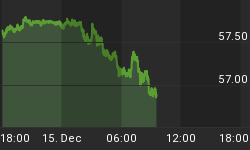Below is an extract from a commentary originally posted at www.speculative-investor.com on 29th April 2007.
Most people involved in the gold sector would realise that over the past few years gold stocks, as a group, have failed to live-up to their reputation as leveraged plays on the gold price. They provided substantial leverage to gains in the gold price during 2001-2003, but during the most recent 3.5 years of the gold bull market an investment in gold bullion has out-performed an investment in the AMEX Gold BUGS Index (HUI). Given that gold stocks are much riskier than gold bullion, this begs the question: why invest in gold stocks?
Before answering the above question we'll take a look at why gold stocks have performed relatively poorly since late-2003 and see if the historical record offers any clues as to what might happen in the future.
We think the following chart-based comparison of the yield-spread (the 30-year interest rate divided by the 5-year interest rate), the gold/GYX ratio (gold relative to a basket of industrial metals), and the HUI/gold ratio contains the reasons for the relatively strong performance of the gold sector during 2001-2003 and its relatively weak performance thereafter. The chart shows that as the yield-spread widened (as short-term interest rates fell relative to long-term interest rates), gold trended higher relative to industrial metals and the HUI provided substantial leverage to gains in the gold price. However, the ability of gold stocks to leverage gains in the gold price evaporated when the yield-spread began to contract and gold began to under-perform the industrial metals.
The crux of the matter is that during 2001-2003 the financial markets were responding to economic weakness, falling liquidity and aggressive rate-cutting on the parts of central banks. In this environment the yield-spread widened and counter-cyclical gold did well relative to cyclical commodities such as the industrial metals, causing the profit margins of gold miners to expand. However, by late-2003 the markets had begun to discount stronger growth, leading to increased financial market liquidity and strength in cyclical commodities relative to counter-cyclical gold. The rising liquidity tide ended up lifting all boats including the golden boat, but in this environment the profit margins of the major gold producers contracted as the cost of mining gold increased faster than the gold price. As a result, gold stocks performed poorly on a relative basis.
It is also worth mentioning that whereas the aboveground supply of gold increases at a slow and steady 1.5-2.0% per year, year-in and year-out regardless of what is happening to the gold price, a gold bull market invariably leads to a rapid increase in the supply of gold shares. As the gold bull market becomes more widely recognised the rate of increase in the supply of gold shares tends to accelerate due, firstly, to the arrival on the scene of many new gold mining companies and, secondly, to most managers of small gold mining companies being embedded with a gene that prevents them from saying "no thanks" when presented with the opportunity to raise money by issuing more shares. In other words, the supply of gold bullion is severely constrained whereas the supply of gold shares can be -- and usually is -- expanded rapidly in response to rising demand.

Interestingly, the performance of the gold sector relative to gold bullion during the current bull market is not dissimilar to its performance during the bull market of the 1960s and 1970s (the gold price was fixed at $35/ounce prior to 1971, but the performance of the gold sector of the stock market indicates that a gold bull market actually began in the early-1960s). Specifically, the following chart of the BGMI/gold ratio (the Barrons Gold Mining Index divided by the gold price) shows that relative to gold bullion the major gold stocks peaked in 1968 and then trended lower for the next 12 years.

The above chart should give pause to those who believe that a drop in the HUI/gold ratio or the XAU/gold ratio to a particular level automatically means that it's a good time to aggressively buy gold stocks. Today's secular gold bull market is probably going to continue for many more years, but if it follows a similar pattern to the previous secular bull market then the major gold stocks will move much higher in nominal dollar terms over the next several years while moving lower in gold terms.
We'll now return to the question: why invest in gold stocks?
As we've said numerous times in TSI commentaries over the past few years, we don't think there is a good reason to favour the MAJOR gold stocks over gold bullion. There will be periods when the large-cap gold stocks trend higher relative to the metal, especially those periods when the yield-spread is widening and gold is out-performing industrial commodities. Such periods will offer opportunities to go 'long' these stocks for intermediate-term trades, but we think long-term investors will be better-served by the bullion. In our opinion, the large-cap gold stocks do not offer enough upside potential, relative to gold bullion, to warrant long-term investors taking-on the additional risk inherent in the stocks.
However, junior gold stocks in general and exploration-stage gold stocks in particular are a different 'kettle of fish'. Despite their risky nature, there are plenty of stocks at this end of the market that have sufficient upside potential relative to the bullion to enable a good case to be made for accepting the risk. Of course, speculators in these stocks must be emotionally equipped to handle high volatility and must diversify to mitigate the effect on the portfolio of a big problem with any single stock.
















